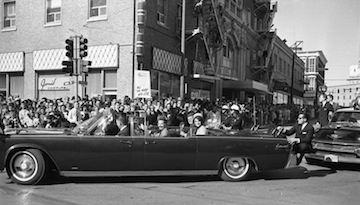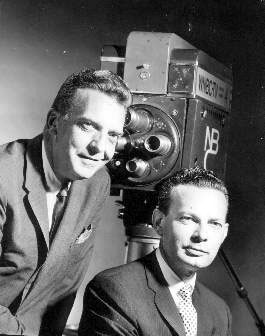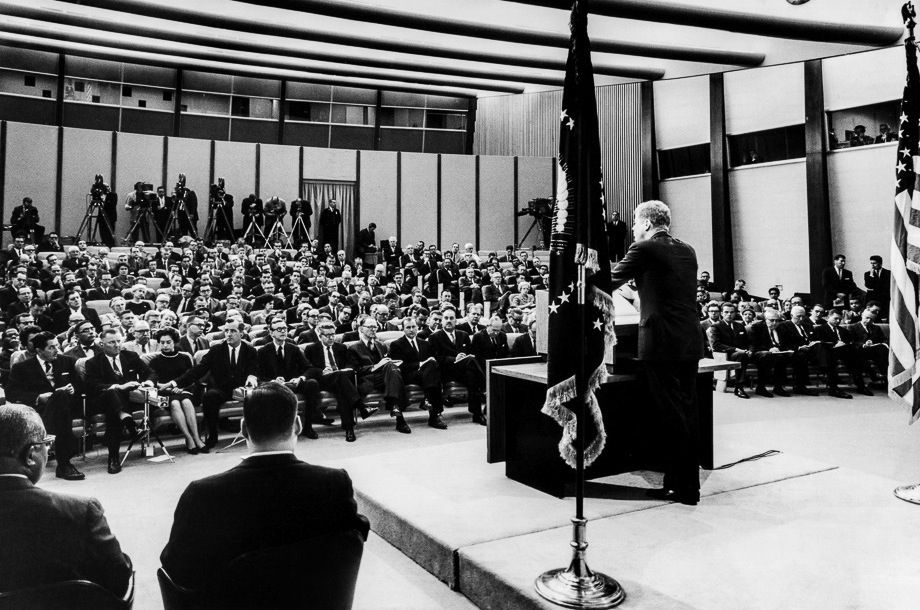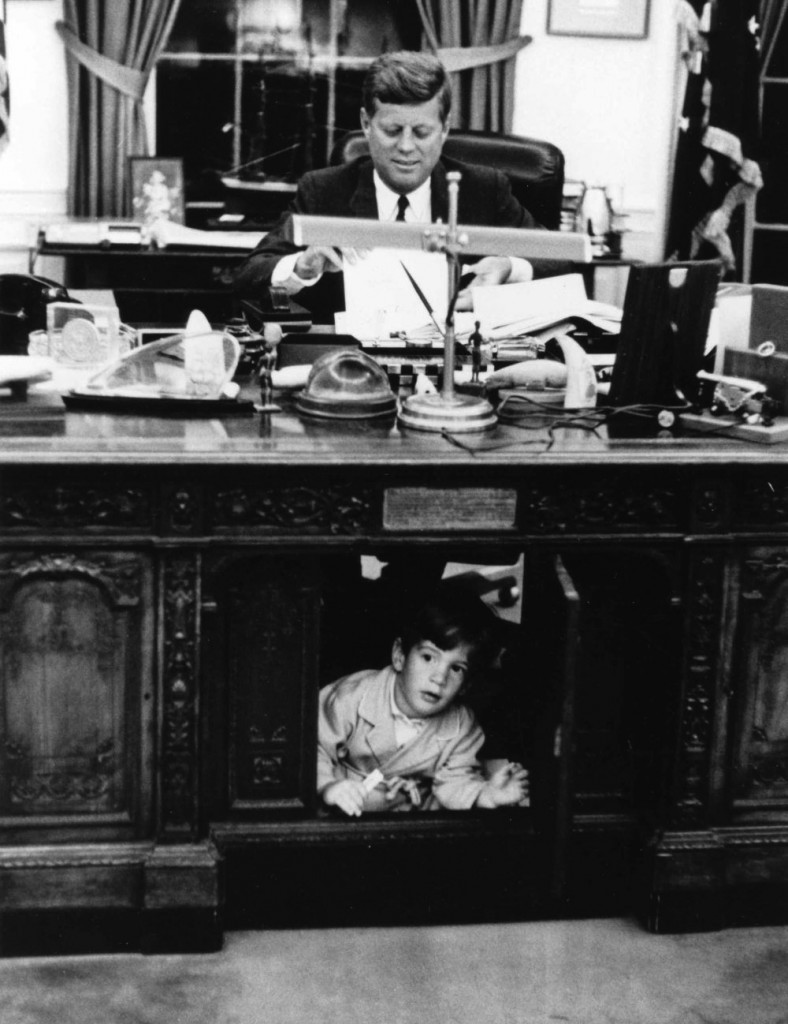On this day, Nov. 25th, in 1963 the assassinated 35th President of the United States was buried at Arlington National Cemetery, ending a 3-day period of national mourning, uncertainty and upheaval.

John F. Kennedy’s presidential motorcade rounds turn in Dallas on Nov. 22nd 1963 en route minutes away to Dealey Plaza and the President’s rendezvous with Lee Harvey Oswald and death.
DESPITE UNFOLDING OF NEW PERSPECTIVES,
IMAGES FROM WEEKEND OF NOV. 22nd 1963
REMAIN PAINFUL TO WATCH EVEN IN 2013
Have optimism & hope been removed
from the world of politics for good?
By David Maril
As someone who lived through the John F. Kennedy assassination 50 years ago, this has been a nostalgic, intriguing and sometimes painful week of absorbing newspaper coverage, TV news documentaries, interviews with historians, pundits, poets, and eyewitnesses reminiscing and reporting on the Nov. 22, 1963 tragedy.
Here’s a notebook of some aspects that caught my attention:
![]() After taking in several of the TV programs using modern scientific techniques to analyze the evidence from the motorcade shooting, I am finally convinced there is nothing that we know of to prove that Lee Harvey Oswald wasn’t the lone assassin/gunman. Whether or not anyone hired or encouraged him is another question that will probably always remain.
After taking in several of the TV programs using modern scientific techniques to analyze the evidence from the motorcade shooting, I am finally convinced there is nothing that we know of to prove that Lee Harvey Oswald wasn’t the lone assassin/gunman. Whether or not anyone hired or encouraged him is another question that will probably always remain.
![]() Even a half-century later and having seen the Zapruder film hundreds of times, it remains excruciating to watch the Dallas presidential motorcade turn the corner with thousands of spectators cheering and waving at the robust-looking President and his beautiful wife seconds before two bullets hit him and ended his life. I think I have fulfilled my lifetime quota of seeing JFK lurch forward and then snap back after the second bullet removes a piece of his skull.
Even a half-century later and having seen the Zapruder film hundreds of times, it remains excruciating to watch the Dallas presidential motorcade turn the corner with thousands of spectators cheering and waving at the robust-looking President and his beautiful wife seconds before two bullets hit him and ended his life. I think I have fulfilled my lifetime quota of seeing JFK lurch forward and then snap back after the second bullet removes a piece of his skull.
![]() It is very striking how emotional many of the usually cynical, detached and hard-edged journalists remain when recounting their recollections of the assassination. Fifty years later they are still struggling to hold back the tears. To many, the shock and pain of seeing a vibrant figure, who epitomized hope, struck down, remains a tragedy that they will never be able to understand.
It is very striking how emotional many of the usually cynical, detached and hard-edged journalists remain when recounting their recollections of the assassination. Fifty years later they are still struggling to hold back the tears. To many, the shock and pain of seeing a vibrant figure, who epitomized hope, struck down, remains a tragedy that they will never be able to understand.
Every time excerpts of a JFK press conference are aired, showing the President having a good time bantering with the press and more than holding his own with his quick wit and personality, it makes you realize how far removed his successors have become from the media and the American people.
Kennedy held press confer- ences on a regular basis and had a lively and active con- nection with the media and the voters. The last few decades, presidents let their press secretaries handle most of the news conferences.
Informative answers have been replaced by “talking points” that seldom answer the questions. When presi- dents do hold their rare press conferences, they seem as uncomfortable as a cat being examined by a vet.
![]() While photographers today from the national press corps are battling the Obama White House for more access, JFK was extremely comfortable allowing cameras to shoot unscripted photographs of his family that enhanced the Camelot image.
While photographers today from the national press corps are battling the Obama White House for more access, JFK was extremely comfortable allowing cameras to shoot unscripted photographs of his family that enhanced the Camelot image.
The photograph of his son, John-John, playing under JFK’s desk in the Oval Office while the president is at work is something you’d never see today.
Of course, it was a different world as far as coverage goes in those days. A president, and the other powerful political figures, did not have to worry about the media reporting marital indiscretions or questionable personal issues. Today, Kennedy’s philandering and severe health issues would not go unreported. In this sense, you can see why Kennedy would be more trusting of the media than presidents today.
![]() Conspiracy theorists who use Jack Ruby’s ease in gaining police-station access when he murdered JFK’s assassin, Lee Harvey Oswald, as evidence the fix was in don’t understand how different security standards were in those days. Today, few people question Major League Baseball’s announcement that next season fans will have to walk through metal detectors when entering stadiums. In the early 1960s, security was not a high priority.
Conspiracy theorists who use Jack Ruby’s ease in gaining police-station access when he murdered JFK’s assassin, Lee Harvey Oswald, as evidence the fix was in don’t understand how different security standards were in those days. Today, few people question Major League Baseball’s announcement that next season fans will have to walk through metal detectors when entering stadiums. In the early 1960s, security was not a high priority.
Veteran CBS newsman Bob Schieffer recalled, as a young newspaper reporter in Texas, that he always wore a sharp-brimmed hat because investigators would think he was a detective and it helped him gain access. Nobody asked questions.
Ruby, who owned a bar in Dallas, used to hang around the police station all the time and savored talking to cops and reporters.
It was a totally different world. When there were not enough mourners at Oswald’s funeral to carry the coffin to the gravesite, reporters covering the event served as pallbearers. Would that ever happen today?

The Huntley-Brinkley Report on NBC-TV was the best and most popular network news show on television for much of its 15-year tenure, 1956-1970, regularly beating CBS News and Walter Cronkite, as well as ABC. (Chet Huntley is at left, David Brinkley, right.)
![]() One of the biggest myths that emerged from the 50-year anniversary coverage relates to Walter Cronkite, the great CBS news anchor. You can understand and accept CBS continually replaying Cronkite’s announcement that Kennedy had died, showing a sign of emotion but successfully holding it back as the credible journalist that he was. He’s one of their guys. However PBS and some of the cable coverage went too far, referencing how his coverage of the assassination made him the dominant television news source.
One of the biggest myths that emerged from the 50-year anniversary coverage relates to Walter Cronkite, the great CBS news anchor. You can understand and accept CBS continually replaying Cronkite’s announcement that Kennedy had died, showing a sign of emotion but successfully holding it back as the credible journalist that he was. He’s one of their guys. However PBS and some of the cable coverage went too far, referencing how his coverage of the assassination made him the dominant television news source.
The truth is that NBC’s Chet Huntley and David Brinkley were just as popular in those days. And, it’s a fact that Huntley and Brinkley crushed Cronkite a year later in the TV ratings in covering the 1964 Republican convention. It was so bad, CBS pulled the plug on the celebrated anchorman and used Robert Trout and Roger Mudd to cover the Democratic convention.
Cronkite, of course, rebounded and in the late 1960s became “Uncle Walter, the Most Trusted Man in America.” A lot of this evolved with his coverage of the Vietnam War. But to credit the Kennedy assassination as what propelled Cronkite into his high status is incorrect.
![]() Speaking of CBS, after viewing numerous clips of a young Dan Rather on the scene, it becomes obvious that he was a terrific reporter, tenaciously tracking down stories, but was not as well suited to be an anchorman. News anchors are supposed to provide a calm, responsible perspective when chaos in the world seems to be breaking loose.
Speaking of CBS, after viewing numerous clips of a young Dan Rather on the scene, it becomes obvious that he was a terrific reporter, tenaciously tracking down stories, but was not as well suited to be an anchorman. News anchors are supposed to provide a calm, responsible perspective when chaos in the world seems to be breaking loose.
Rather, when he anchored CBS News, always gave the feeling he might flip-out at any moment, and he seemed ill at ease being forced to be strapped in a chair for half an hour instead of pursuing a story in the field. His uneven performance at the anchor desk makes it harder to remember what a tremendous reporter he had been.
![]() In a perfect world, all the anniversary coverage, which revealed JFK’s vigor and emphasis on public service, would have a positive effect on today’s cynical and self-serving world of politics. Unfortunately it just makes us more aware of the feeling of hope and promise we lost when those shots were fired in Dallas.
In a perfect world, all the anniversary coverage, which revealed JFK’s vigor and emphasis on public service, would have a positive effect on today’s cynical and self-serving world of politics. Unfortunately it just makes us more aware of the feeling of hope and promise we lost when those shots were fired in Dallas.
davidmaril@hermanmaril.com
“Inside Pitch” is a weekly opinion column written for Voice of Baltimore by David Maril.
EDITOR’S NOTE: The “Zapruder film” was shot with a home-movie camera by private citizen Abra- ham Zapruder as President Kennedy’s motorcade passed through Dealey Plaza in Dallas on Nov. 22, 1963. The film inadvertently captured the assassination and shows more clearly than anything else the fatal shot to Kennedy’s head. It is one of the most studied pieces of film in history.
CHECK OUT LAST WEEK’S “INSIDE PITCH” COLUMN: click here
…and read previous Dave Maril columns by clicking here.






November 30th, 2013 - 10:54 PM
[…] OUT LAST WEEK’S “INSIDE PITCH” COLUMN: click here …and read previous Dave Maril columns by clicking here. Filed under: Top Stories […]
December 3rd, 2013 - 1:48 PM
Call it ironic, but why bother adding an editor’s note informing us that the Zapruder Film is the most studied pieces of film in history. Everybody knows that!
December 21st, 2013 - 12:48 AM
Air Hogs Sharpshooter RC helicopters are great choice for RC helicopters for kids. The Air hogs feature stability control flying and are equipped with missile launchers that can fire at the targets or they can participate in air to air combat. Your kids will get the feel that they are actually in real time battles and will develop their own strategies to come out safely. These fire 6 missiles and has two targets each. From reading the description, it sounds like they are very accurate which would make them even more fun for the kids and the adults. Adults will enjoy these two which will make it nice for a parent and the children to have an adventurous day at the park. fake beats by dre http://greatamericancomputer.com